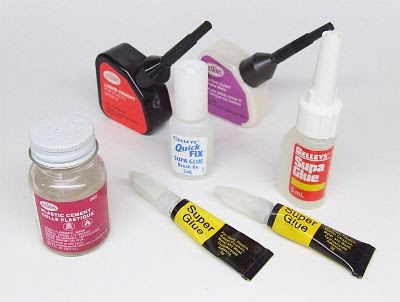When I was a kid the standard household tube glue in England was called Bostik, and if I remember correctly my earliest Airfix kits (bagged, Series 1, chosen from the front window of the newsagent at the end of the street -- ah, what a memory!) were assembled with this stuff. It was stinky, it was stringy, and it blobbed, but it was all there was! When I came to Australia with my family in 1971 the model glue of choice here was Britfix, I think there was a ‘77’ on that name but it’s too long ago to be sure. It was stinky, it was stringy, and it blobbed, in fact in every meaningful way it was Bostik in a different tube, so while it left something to be desired, it was familiar.
These were the days when parts had to be left for ages to dry, clamped and rubber-banded, even overnight, and one would cautiously remove the bands to see if things had actually set or if the model would fall apart when moved. This, despite Britfix actually being rated a ‘welding’ glue, i.e., solvent-based. Landing gear was fragile beyond words and the glues available took a mature touch to get them to cooperate--little wonder all my fighter planes as a kid were built gear-up.
I was 12 when I first encountered Testors Liquid Cement, and I thought Christmas had come. A strong cement (note, the word ‘glue’ had abruptly become old-fashioned), which applied neatly with that handy brush built into the bottle cap (praise be to the engineer who thought of something truly practical!), and which dried essentially invisible. And it had grip! The first model I tackled with it was Monogram’s 1:72 B-52, ambitious for an early teen if I say so myself.
Things remained static for many years, then. ‘Superglue’ was a mysterious and dangerous substance around which the words ‘skin graft’ floated. I remember being with my dad when he bought a tube one day (mid-70s, I guess) and the retailer cautioning him about it sticking fingers together, that it was indestructible and a skin graft would be required if this dreaded accident occurred.
The truth was a closely guarded secret in marketing terms, I only heard the facts recently. I thought it was miraculous back in the 90s when I bought some PicApart, a simple water-based solvent that dissolves cyanoacrylate, but of course the chemists who invented the stuff (in the 1960s, I heard, as a battlefield surgical tool for sticking wounds together when there was no time for stitches!) had always known its strengths and weaknesses. Acetone is the principle solvent, which is why it’s a fair bet so many macho hobby guys who build powerful, filthy tanks, rusted to perfection and draped with the battle flags of fascists and communists, have a bottle of nail polish remover hidden somewhere in their workshops. Probably behind the bottle of brake fluid they use to strip old paint, but that’s another post!
At first I resisted using superglue, it seemed too strong, liable to melt plastic or lock up parts in the wrong order. Meah... It you want severe, try Revell Contacta Professional, in the precision applicator, I’ve never seen plastic disintegrate like it before or since. (Except that fine component in a Hobbycraft kit that dissolved before my eyes under the assault of old fashioned Testors Liquid Cement, but that’s another post too...) I think I began to use superglue after reading Paul Boyer’s Basic Techniques/Advanced Results series of articles in FSM in the early 90s, and realised that a precise parts-fit coupled with superglue in the seam created a rock-solid joint which could be dressed with a knife blade and sand paper and -- wallah! -- the seam was invisible.
This was the holy grail of finishing skills at the time, how to defeat the appearance of the model being a model.
I developed that skill in the decade following until it was easy as breathing. When my brother in law came down from the States many years ago he looked at my models and the first thing he said was ‘I can’t see how it went together... How did you do that?’ (I rarely preen, but that was an occasion.) The model I think was Horizon’s 1:30th scale vinyl T. rex, a model which took ingenuity and a swag of different techniques as I had never built a vinyl before … and never seen gaps like those either. Superglue to the rescue (and shims, putty and plasticine). Another kudo...
What would we do without superglue? Joints would all need putty again, unless the fit was precise enough to be closed up firm with liquid cement alone (old kits and limited-run subjects would be a lot less popular). Rubber bands and clamps would be in demand. “Allow to dry overnight” would reappear in instructions, and kitchen tables would be commandeered with stacks of books and paint bottles carefully balancing models in the dark hours while landing gear dried (shhh, tiptoe past in case it moves!), then there would be a giddy experimental moment the next day when the set was tried out and the hobbyist held his or her breath to see if that carefully finished fighter’s landing gear would collapse under it.
Nostalgia, with a certain jaundiced outlook -- and maybe superglue isn’t solely responsible for remedying these ills, I’m sure a competent builder could put a quality modern kit together with the tube glue still rated safe for junior modellers, and come up with a perfectly good result. But a touch of the cya sure makes things easier!





No comments:
Post a Comment